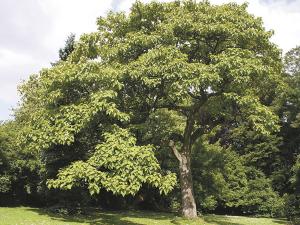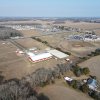Empress trees are extremely fast-growing
The nice thing about most ornamental trees is that they are slow-growing beauties that stay virtually unchanged over the years. The nice thing about one particular ornamental tree is that it is extremely fast growing, with huge vanilla-scented blooms. A Dutch botanist named the genus Paulownia in honor of Anna Pavlovna, Queen Consort of the Netherlands. These trees are also called Empress Tree, Princess Tree and Foxglove Tree.
Paulownia grows fast; its wood is strong yet light; its nectar-rich flowers attract honeybees, and the huge leaves are good fodder for farm animals. Because of its tendency to leaf out late in the spring along with its open canopy that lets in light, you can plant crops underneath the trees.
The Japanese call the tree kiri, where an old custom calls for planting an Empress Tree at the birth of a baby girl. When the girl has grown and is ready to marry, the quick-growing Empress Tree is cut down and the wood made into furniture as a wedding present.
The wood itself is fine-grained, light, and resists warping and cracking. Because of its low silica content that reduces dulling of blades, it is used to build boxes to hold sharp Japanese tools. The wood is cut for guitar making as well as lightweight skis.
These trees are amazingly fast growing, shooting up to 20 feet in a single year. There are many species of Paulownia with Paulownia elongata useful as an ornamental tree with its striking purple flowers.
Plant your Empress Tree in full or partial sunlight, in sandy or other well-draining soil. If your soil is heavy clay or poorly draining, try adding compost and some sand. The ideal soil pH is 5 to 7. Because of its rapid growth, your Empress Tree needs rather high rates of fertilizers, with nitrogen needed most. You can get by with a good organic general fertilizer.
Plant your Empress Tree in a hole that is just slightly shallower than the root ball and twice as wide.
Using your fingers, gently fan out the roots. Keep the point where the root flares out and the trunk begins an inch above the surrounding ground. Check that the tree is perfectly upright before filling in the planting hole. Water well, but do not keep the tree soggy.
A good three-inch-deep organic mulch of leaves or straw will help retain moisture. Be sure the mulch doesn’t touch the tree trunk.
If the tree leaves are yellow or light green it may mean you need more fertilizer; just don’t overdo it, or you can burn the tree roots. To allow new growth to harden off before winter, never fertilize after mid-July.
These deep-rooted trees rarely uproot sidewalks, although it’s wise to keep all tree plantings away from sewer or water pipes. In addition to use as animal feed, the huge leaves make a good mulch that breaks down quickly releasing nutrients into your garden.
Some growers cut the tree at ground level, resulting in rapid growth, forming a tall and straight trunk.
The fire-resistant lumber is a very good insulator of cold or heat. Empress Trees are hardy in USDA Zones: 5-11. They are usually only available by mail order from companies such as Ty Ty Nursery (888-758-2252, P.O. Box 130, Ty Ty, GA 31795-0130) or Nature Hills Nursery (www.naturehills.com or 9910 N. 48th St., Suite 200, Omaha, NE 68152; 888 864-7663).
Plant Empress Trees this spring and you will have a true Jack in the Beanstalk plant that will shoot up 10 or 20 feet with lush, long-lasting, vanilla-scented blossoms. The leaves are huge and make great mulch or livestock feed.
There is a word of caution, that certain varieties of the Empress Tree, much like the royalty it is named after, can sometimes become invasive.























































